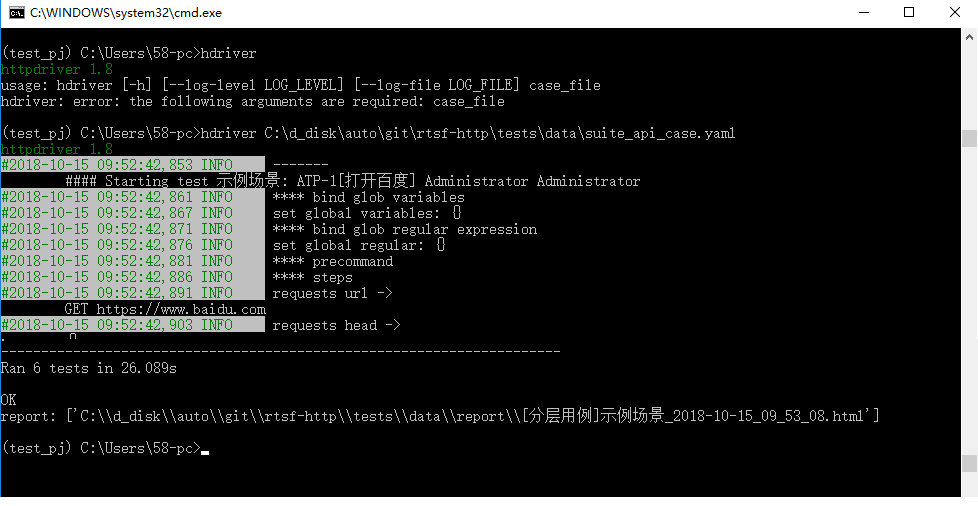only for http(s) test, base on rtsf
Project description
rtsf-http
基于rtsf测试框架,关键字驱动测试http/https等api
环境准备
安装rtsf-http
pip install rtsf-http
简单介绍
- 基本使用,参见rtsf项目的 使用入门
- rtsf-http 遵循在rtsf项目高阶用法的约定
- 实际上,rtsf-http仅仅做了两件事情
- 设计http(s)接口自动化测试yaml用例,并重写Runner.run_test的执行规则
- 封装常用requests为用例提供yaml函数
用法介绍
安装完成后,有两个命令用于执行yaml测试用例,它们的效果是一样的: hdriver 或者 httpdriver
# 简单用法
hdriver c:\xxx\xxx\test.yaml
# 设置日志级别和路径
hdriver c:\xxx\xxx\test.yaml --log-file c:\xxx\xxx\test.log --log-level debug
用法,实例如下:
rtsf-http的约定
依据rtsf的yaml约定模板,我们在steps中,为rtsf-http约定了一个规则,以便识别为 http的接口自动化测试, 如下
steps:
- request:
url:
method:
params:
data:
json:
files:
auth:
...
url和method必填,其他参数遵循requests
rtsf-http常用的yaml函数
# 常在glob_var关键字中使用的
GetBasicAuth(username,password) # -> 获取basic加密,用于传递 requests的auth参数
GetDigestAuth(username,password) # -> 获取digest加密,用于传递 requests的auth参数
# 常在precommand关键字中使用的
SetVar(name, value) # -> 设置变量至变量空间。 但是,不建议使用SetVar定义变量
# 定义变量建议使用 glob_var和glob_regx, 详细说明参见rtsf项目。 yaml示例如:
glob_var:
username: luokefeng
password: 123456
basicauth: ${GetBasicAuth(luokefeng,123456)}
glob_regx:
rex_lt: 'name="lt" value="([\w\-\.\+/=]+)'
rex_execution: 'name="execution" value="([\w\-\.\+/=]+)'
# 常在postcommand关键字中使用的, 动态参数化数据
DyStrData(name,regx,index=0) # -> resp.text or resp.content 返回html/xml等格式时, 依据正则regx和下标index,保存至变量name
DyJsonData(name,sequence) # -> resp.text or resp.content 返回json格式时,依据sequence,保存至变量name
# 常在verify关键字中使用的, 验证结果
VerifyContain(strs) # 验证相应的body中,包含字符串
VerifyCode(code) # 验证响应码为code
VerifyVar(name, expect_value=None) # 验证变量的值是否为期望值;如果期望值为None,则仅验证变量是否被赋值
# 下载的请求示例,yaml编写:
steps:
- request:
url: https://www.baidu.com
method: get
download_dir: c:\downloads
# 上传的请求示例, yaml编写
steps:
- request:
url: http://127.0.0.1/filestorage/httpUploadFile
method: post
files:
pic1: C:/d_disk/auto/buffer/800x600.png
pic2:
pic3:
data:
dirType: 1
unzip: 0
自定义,yaml函数和变量
在case同级目录中,创建 preference.py, 该文件所定义的 变量、函数,可以被动态加载和引用, 具体参见rtsf的介绍
简单使用
依据rtsf和rtsf-http的约定, 做了几个接口测试的示例
Get请求
- 请求百度首页,校验title
# example_1.yml
- project:
name: demo_rtsf_test
module: demo_test_baidu
- case:
name: www.baidu.com
glob_regx:
rex_name: 'id=su value=([\w\-\.\+/=]+)'
steps:
- request:
url: https://www.baidu.com
method: GET
post_command:
- ${DyStrData(baidu_name,$rex_name)}
verify:
- ${VerifyCode(200)}
- ${VerifyVar(baidu_name, 百度一下)}
- 执行命令,运行用例
hdriver example_1.yml
- 查看报告
Post请求
- Basic或者Digest加密认证,登录请求。
# example_1.yml
- project:
name: demo_rtsf_test
module: demo_test_login
- case:
name: basic_auth_login
glob_var:
basic_auth: ${GetBasicAuth(username, password)}
digest_auth: ${GetDigestAuth(username, password)}
steps:
- request:
url: http://xxx.xxx.xxx/login
method: POST
auth: $basic_auth
verify:
- ${VerifyCode(200)}
- 常规的登录请求示例
# example_2.yml
- project:
name: xxx登录
module: 登录
- case:
name: /login?service=https://xxx.xxx.xx/xxx
glob_var:
username: luokefeng
password: 123321
steps:
- request:
url: https://www.xxx.com/login?service=https://xxx.xxx.xx/xxx
method: POST
params:
username: $username
password: $password
mobile: 14512341234
verifycode: 123456
_eventId: submit
submit:
_rememberMe: on
verify:
- ${VerifyContain(xxx后台)}
请求过程中的动态参数化
比如 api_1 请求返回的结果中,记录一个 xxx_id,给 api_2接口使用
# example_3.yml
- project:
name: xxx
module: xxx
- case:
name: /api_1?service=https://xxx.xxx.xx/xxx
glob_var:
data_contract_id: 23423543
workerid: 123321
steps:
- request:
url: https://xxx.xxx.xxx/api_1?service=https://xxx.xxx.xx/xxx
method: POST
params:
unsignReason: 2
unsignDetailReason: 21
unsignStage: 3
blackReason: 主动申请
contractId: $data_contract_id
workerId: $workerid
post_command:
- ${DyJsonData(xxx_id, data.contractId)}
verify:
- ${VerifyCode(200)}
- ${VerifyContain(成功)}
- case:
name: /api_2?service=https://xxx.xxx.xx/xxx
steps:
- request:
url: https://xxx.xxx.xxx/api_2
method: GET
params:
contract_id: $xxx_id
verify:
- ${VerifyCode(200)}
- ${VerifyContain(成功)}
动态参数化,提供了两个yaml函数: DyStrData 和 DyJsonData
数据驱动和分层用例
在 rtsf项目中,已经有了详细的介绍
分层实例场景
示例场景1: 打开百度,搜索hello,打开bing
示例场景2: 打开bing, 打开百度,搜索hello
应用分层:
- 打开百度 封装为 api_1, 搜索hello 封装为api_2, 打开bing封装为api_3;
# api_test.yaml
- api:
def: api_1()
steps:
- request:
url: https://www.baidu.com
method: GET
verify:
- ${VerifyCode(200)}
- api:
def: api_2($keyword)
steps:
- request:
url: https://www.baidu.com/s?wd=$keyword
method: GET
verify:
- ${VerifyCode(200)}
- api:
def: api_3()
steps:
- request:
url: https://cn.bing.com
method: GET
verify:
- ${VerifyCode(200)}
- suite1排列api_1、api_2、api_3;
# suite_test1.yaml
- project:
def: suite1($keyword)
- case:
name: suite1_demo_baidu
api: api_1()
- case:
name: suite1_demo_baidu_key
api: api_2($keyword)
- case:
name: suite1_demo_bing
api: api_3()
- suite2排列 api_3、api_1、api_2
# suite_test2.yaml
- project:
def: suite2($keyword,$password,$username)
- case:
name: suite2_demo_bing
api: api_3()
- case:
name: suite2_demo_baidu
api: api_1()
- case:
name: suite2_demo_baidu_key
api: api_2($keyword)
- 最后测试用例排列 suite1 & suite2
# test_case.yaml
- project:
name: 分层用例
module: 示例场景
- case:
name: 示例场景-case1
suite: suite1(hello)
- case:
name: 示例场景-case2
suite: suite2(hello,123456,luokefeng)
- 执行 hdriver.exe test_case.yaml
Project details
Download files
Download the file for your platform. If you're not sure which to choose, learn more about installing packages.
Source Distribution
rtsf-http-2.1.6.tar.gz
(11.1 kB
view hashes)
Built Distribution
Close
Hashes for rtsf_http-2.1.6-py2.py3-none-any.whl
| Algorithm | Hash digest | |
|---|---|---|
| SHA256 | feacc3b0e0e3db270b591063f2f140f7276f361da64bc5e59e10070847b08e93 |
|
| MD5 | 9699a57f1595018e03a32909f25c9614 |
|
| BLAKE2b-256 | c494f3abed807d61f9f5921e95d8af1b23bb8627eb2a58e90beb311a1832867f |













